
Please send all Checks and Money orders to :
Dave Taylor P.O. Box 87 Sylvania, OH 43560
419-842-1863
Click Here to E-mail Us!
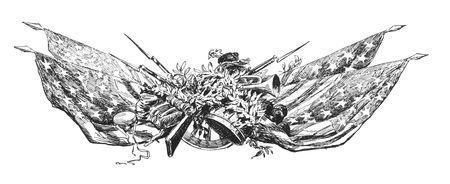
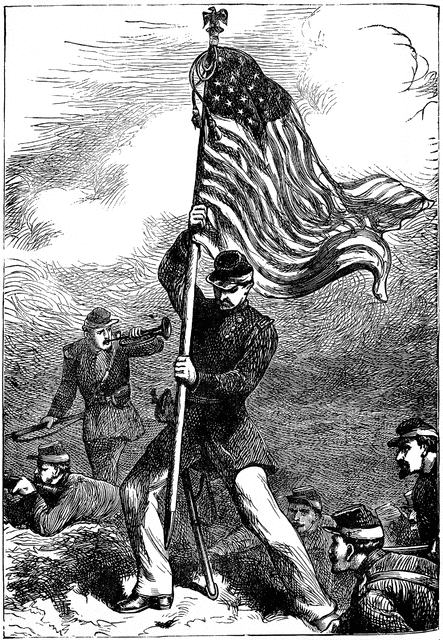
17-05-01
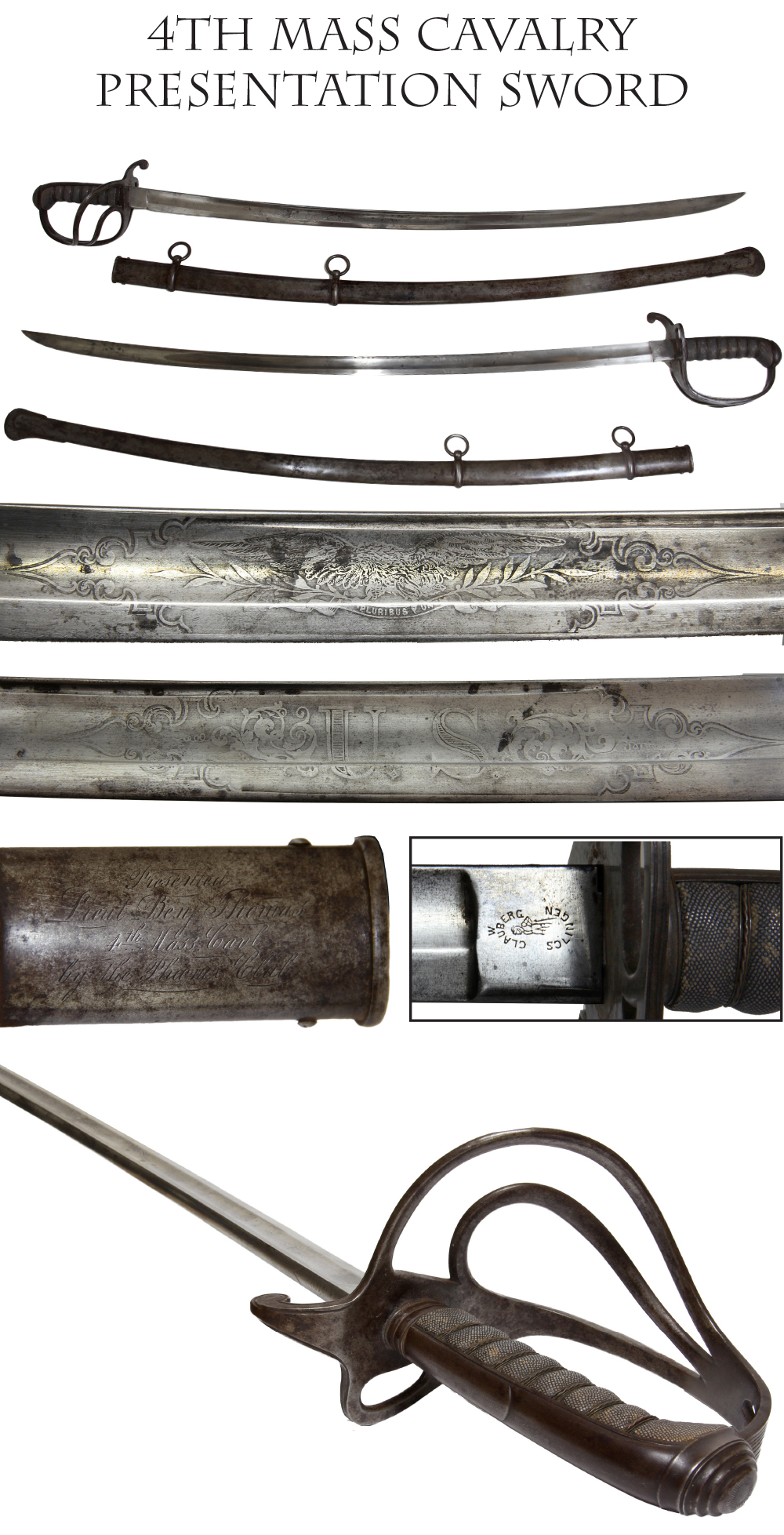
17-05-00….4th Mass Cavalry Presentation Sword … Iron hilted US import saber by Clauberg of Solingen in the style of the British 1823 pattern with a backstrap, knucklebow and two outboard branches, and a small inboard loop on the counterguard. “W. Clauberg” over a standing knight, over “Solingen” on the ricasso. Blade is nice, with good edge and point, and with visible etched panels: a “US” amid floral scrolls on one side and an American eagle with an “E Pluribus Unum” ribband on the other side. Blade overall shows a dull silver mixed with bright. Nicely engraved in a flowing script on the scabbard beneath the throat is: “Presented/ Lieut. Benj. Thomas / 4th Mass. Cavl. By the Phoenix Club” The Phoenix Club was a social club in Hingham, Mass., formed first in 1849 that adopted that title in 1856. It was largely engaged in organizing sociable, fancy dress-balls and 4th of July parades. The 4th Mass Cavalry was organized in February, 1864, by combining a battalion of the 1st Mass Cavalry with two other battalions formed in February and April. The battalions operated largely on their own during the war. Company C was part of the 2nd Battalion commanded by Major Keith and was sent to Hilton Head, where it took part in an expedition up the Ashepoo River in May. Two of the companies were then sent to Florida, where they were active in a number of expeditions and skirmishes, as were the two that remained on Hilton Head. The regiment lost 4 officers and 28 enlisted men killed or mortally wounded in their engagements. Thomas was from Hingham, Mass. and enlisted 12/17/63 as a Second Lieutenant and was commissioned in Co. C on 1/6/64. On 2/1/64 he was promoted to First Lieutenant and Quartermaster, which indicates he had some education and talent for organization. At some point he was even promoted to Acting Assistant Quartermaster for the Tenth Army Corps. He served through 12/9/64 and after the war he was a member of G.A.R. Post 29 in Waltham, Mass. He supplied a memoir of his service to the town’s history its service in the Civil War: In November, 1863, Mr. Thomas received an appointment as recruiting-officer; and, in the following December, was commissioned second lieutenant. Located at the time in Boston, he continued the work of enlistment; and, being quite successful, was commissioned Jan. 1, 1864, as first lieutenant, and assigned to the Fourth Mass. Cavalry as quartermaster. In April, 1864, with the regiment, was ordered to report to Gen. Gilmore, then in command of the Department of the South, with headquarters at Hilton Head, and three days after again embarked under orders to report at Fortress Monroe. His next destination was City Point, for the purpose of co-operating, under Gen. Butler, with all the armies of Virginia, in the “on to Richmond” movement of that year. Being the advance guard to City Point, the duties were numerous and the labor severe. Mr. Thomas, as quartermaster, was required to be constantly on the move. Besides being responsible for the supply of rations for men and horses, and other material for the general prosecution of the war, a further duty was imposed as “ordnance officer,” by appointment of the colonel commanding. Soon after there came an acceptable change, in being detailed as A. A. Q. M. of the Tenth Army Corps, under Gen. Terry. Here he continued his labors until, by order of Gen. Butler, the corps was disintegrated, and united with others. Following this movement, Quartermaster Thomas, with other staff officers, was ordered to report to Gen. Weitzel, who had just been placed in command of the Twenty-fifth Corps, composed of twenty-five thousand colored troops. Some disaffection was created with respect to the classing of white troops with colored; but good feelings had the ascendency, and better judgment prevailed. Mr. Thomas affirms, that, during his entire experience, he found neither better nor braver men. In November and December of 1864, he aided in fitting out the noted Fort Fisher expedition under Gen. Butler, the result of which is well known. At the close of the year, he resigned his situation on account of repeated domestic affliction. Mr. Thomas retired from the service, having acceptably performed his multiplied and often perplexing duties. This is a nicely engraved presentation sword carried by an officer in a post that did not carry a lot of glory but immense responsibility. Inscribed cavalry officer’s sabers to cavalry officers are pretty darn scarce. $2,950.00
Call us @ 419-842-1863

17-05-01…1858 DATED FIRST PATTERN M-1855 SPRINGFIELD RIFLE MUSKET… Very good ++ condition 1858 dated Springfield Model 1855 with crisp markings and excellent wood showing just the slightest rounding. This is the first pattern 1855 musket with brass nose cap, no patch box, and early style long-range rear sight. All bands, springs, sights, rod, and swivels in place. Mechanism tight. Bore is good. This even has a roll of original Maynard primers in it. Sharp lock markings and Springfield eagle on the primer door. Matching 1858 barrel date with V/P/eagle’s head proofs. Metal smooth and in the bright, just fading to a dull silver. Very minor handling marks on the wood, generally a rich, deep brown tone. Inspector’s cartouche is visible on stock opposite the lock. 100% complete, 100% original, and mechanically perfect. An extremely nice example of this classic US rifle musket that you won’t be ashamed to have in the gun rack. One of the most highly sought of all Civil War Springfields.
Sale pending
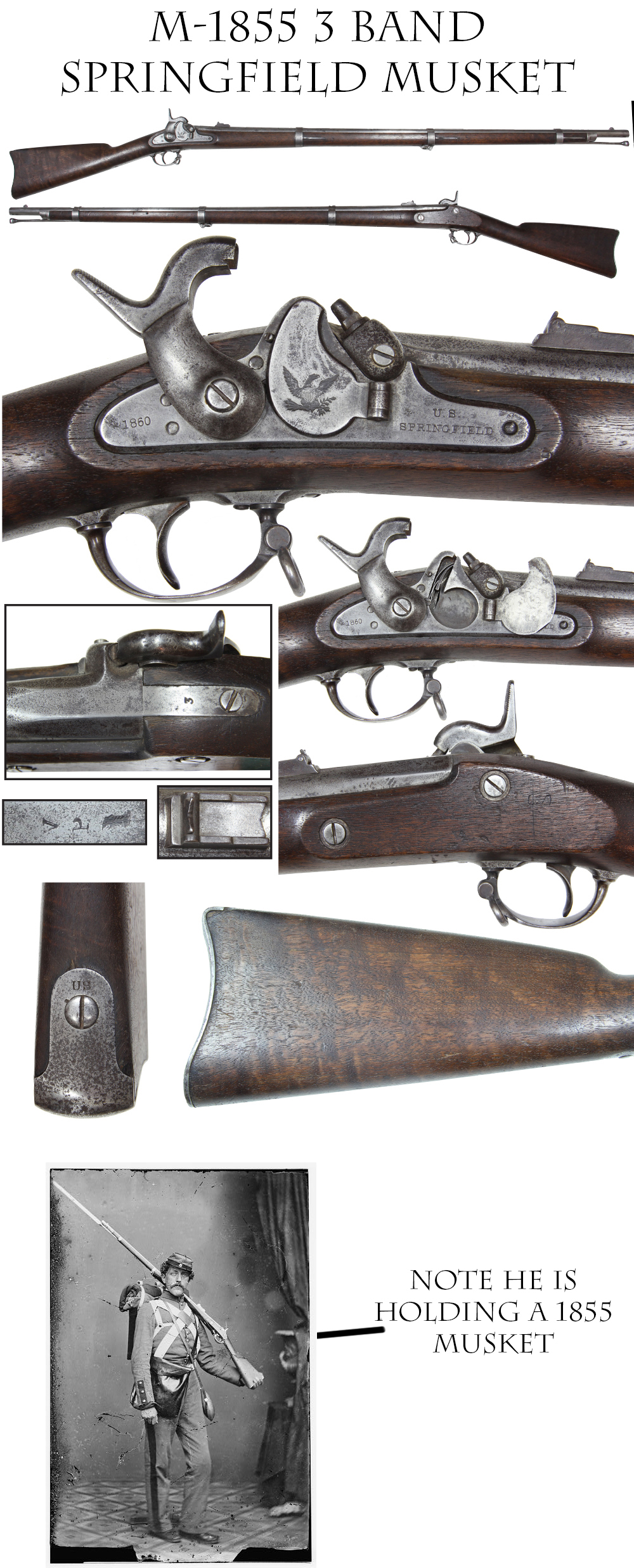
17-05-02…1860 DATED MODEL 1855 SECOND PATTERN SPRINGFIELD RIFLE MUSKET… Having two ’55 rifle muskets on the list seems like bragging, but “what the heck” … I like them and can’t not buy one when I get the chance. The metal on our 1858 dated example listed elsewhere is slightly better but the wood on this is a tad crisper, so you have your choice. Clear lock plate stamps and primer door eagle. Bolster shows some pitting from firing corrosion as does the breech. The barrel proofs are visible but light and the barrel date is present but faint. A rack number “3” is stamped on the breech plug tang. All bands, springs, sights and rod are in place. Mechanism good. Bore is decent. This has the iron nose cap and short range rear sight with stepped base, both elements of the second pattern M1855. It is believed that all Harpers Ferry 2nd Models have patch boxes. Also, some of the early Springfield examples have patch boxes. But late production Springfield second models do NOT have patch boxes which is 100% correct and proper, as is seen here. Some dappled deep gray on the buttplate. A light vise marking on the left barrel flat. Metal generally a dull silver gray, smooth with the exception of the breech spotting. NRA “very good condition”. Rear sight has short range leaf but lacks the long range leaf. Aside from this… 100% original, 100% complete, and mechanically perfect. The wood has very good, sharp edges, very minor handling marks, just two small edge dings between the upper bands, and nice deep brown color. It has a visible inspector’s cartouche on the flat plateau opposite the lock. Another nice example of this highly sought Civil War long arm. $2,650.00
Call us @ 419-842-1863

17-05-03.. SOLID CONDITION CIVIL WAR HAVERSACK … A very nice example of a scarce piece of gear. Even in the old days when surplus dealers had literally stacks of Civil War knapsacks in stock, the haversacks were scarce for the simple reason they were so useful and were used up rapidly after the war in the civilian market. This is not only a scarce survivor, but is in very good condition with a fully intact shoulder strap, latch tab and buckle. The three stamped tin buttons on the interior that held the rice bag are still in place and there are no significant tears or holes. This is a nice early to mid-war example with the tab and buckle secured by stitching alone and no rivets. A key piece of Civil War gear that is essential in any collection.
$1,650.00
sold
Call us @ 419-842-1863
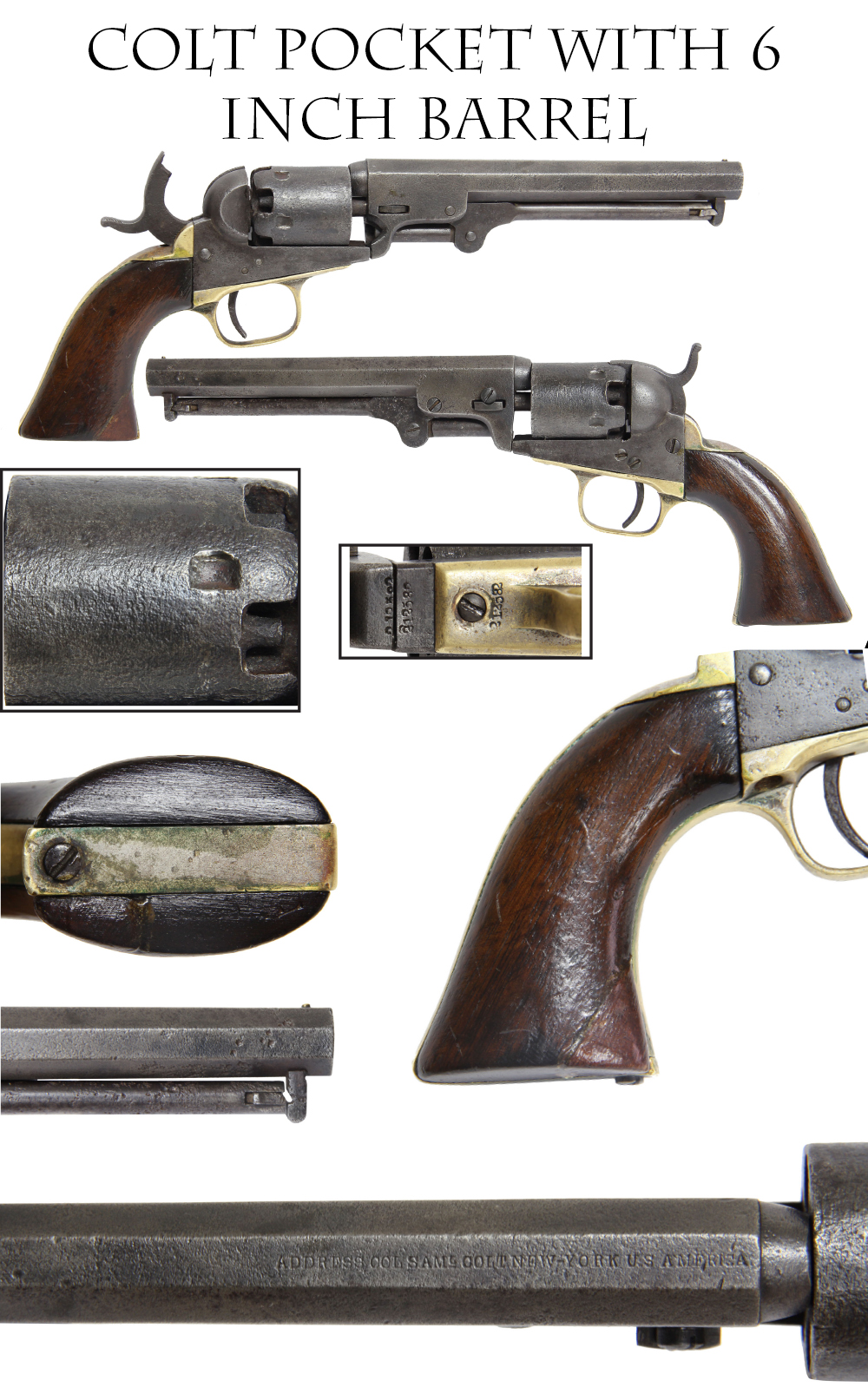
17-05-04… AFFORDABLE COLT POCKET WITH 6 INCH BARREL:… 1849 model Colt pocket revolver, serial number 212,582, giving it an 1862 production date. Gray metal with scattered light pitting overall on barrel assembly and cylinder. Lighter scattered pitting on frame. Grips show a repair to the lower right with a piece of wood patched in and some disturbance to the varnish in doing the repair. Some scattered dings to metal and wood here and there. Light peppering overall. Cylinder is a bit rough, but barrel address is legible. Replaced wedge and screw, otherwise complete. Indexes “ok” if you point the muzzle up. I try to avoid using the word “never”, but examining the butt strap here I am convinced it was never marked with a serial number. A well-used Colt “forty-niner” that was very popular with early western travelers, being intended to capitalize on men heading to California during the Gold Rush. These were also very popular side arms for Civil War officers, being lighter to carry than the Navy or Army models. This one shows age and use, but doesn’t deceive with any hidden flaws. A great value at… $625.00 d-rpal
sold
Call us @ 419-842-1863

17-05-05.. 17-05-05… ALLEN & THURBER .36 CALIBER PISTOL WITH 6-INCH BARREL:…Center hammer single shot American pistol by Allen and Thurber. Nice 6-inch barrel, octagon to round. Frame a dull silver grey with some brown spotting, barrel about the same. Smooth metal overall. No pitting. Action is good. Grips have shallow gouge lines incised at the screw head on right side and a few scattered dings, but good overall. These pistols were quite reliable with their simple construction and were made in several calibers and numerous barrel lengths from the 1840s to the beginning of the Civil War. Frequently labeled “Boot Pistols” as they lent themselves perfectly for concealment in one’s boot. “Cast steel” barrel stamp on barrel flat and batch number “304.” Top flat retains worn ALLEN & THURBER marking. A simple, classic American single shot percussion pistol by a very well known maker. $365.00
sold
Call us @ 419-842-1863
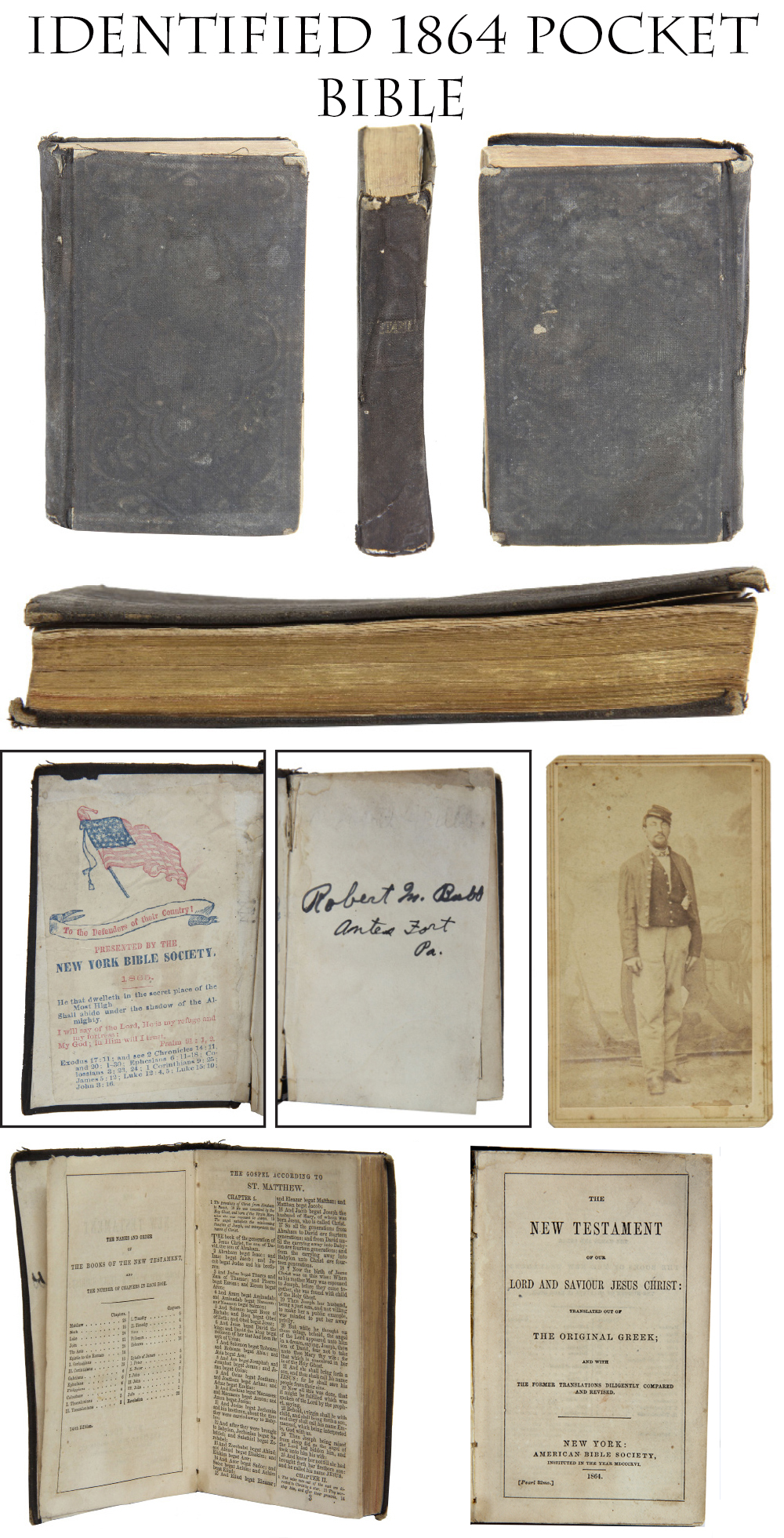
17-05-07… 1864 POCKET TESTAMENT WITH A PATRIOTIC PRESENTATION BOOK PLATE FOR SOLDIERS PLUS CDV PHOTO: … An 1864 pocket size New Testament with a patriotic, color 1865 dated New York Bible Society presentation plate inside the front cover. A nice representative example of a pocket Bible intended for US Volunteers in the Civil War. An old ink inscription on the flyleaf reads “Robert M Bubb / Antes Fort Pa.” with the name also in light pencil above that. Accompanying is a soldier CDV with Penna back mark. There are 29 soldiers surnamed Bubb from Pennsylvania but none named Robert. Census research shows a Robert Bubb born in that area in 1874, so chances are it was carried in the war by a relative and found its way into Robert’s hands later. If you feel industrious you can research the census records for all 29 Bubbs, and see which one(s) had a son named Robert. In any case, it has a great color, wartime label in the front and is a nice example of a bible intended expressly for presentation to departing soldiers in the Civil War. …
$185.00
Call us @ 419-842-1863

17-05-08… TRULY HISTORICAL M-1852 US NAVAL OFFICERS SWORD INSCRIBED TO SAMUEL B. MEADER … Excellent condition, inscribed, regulation USN 1852 officers sword and scabbard. An unmarked European import with unstopped fuller. This top shelf sword came out of the respected navy collection of Orton Begner. He was an old and good friend who recently passed away. He had great taste and much of the navy material I have offered in recent lists came from his collection. This sword was his BEST edged weapon. This sword has a nice wide blade with vivid etching that retains much of its original frosting. The etching encompasses typical nautical motifs such as a USN marked pennant, anchor, eagle, etc., and an etched central panel with Samuel B. Meader etched in script. The black leather scabbard is solid and the brass hilt and mounts retain good amounts of their gilt finish. The rayskin grip is all there and the brass binding wire is tight. Even the red felt pad at the blade shoulder is still in place. Samuel Burnell Meader (1817-1867) was a native of Nantucket and life-long mariner. As master of the ship Martha, he sailed to the Pacific Ocean on a voyage lasting from 1852 to 1857. When the war broke out he was appointed Acting Master in US Navy on Nov. 13, 1861, and served aboard the USS Mystic in the North Atlantic Blockading Squadron. In 1862 the ship was credited with helping to capture or destroy four blockade runners off the North Carolina coast. In mid-1863 the vessel operated on the York River, and in September of that year captured another vessel off Yorktown. He was honorably discharged February 4, 1866, and died of copper poisoning just a year later. This is a beautiful regulation 1852 pattern USN officers sword with a good file of biographical and service material that comes with it and will likely yield even more interesting information. I show an oil portrait of Meader done during his civilian sea-faring days. Note the long naval telescope and the ship off in the distance behind him. An interesting and historical sword… $2,850.00
sold
Call us @ 419-842-1863
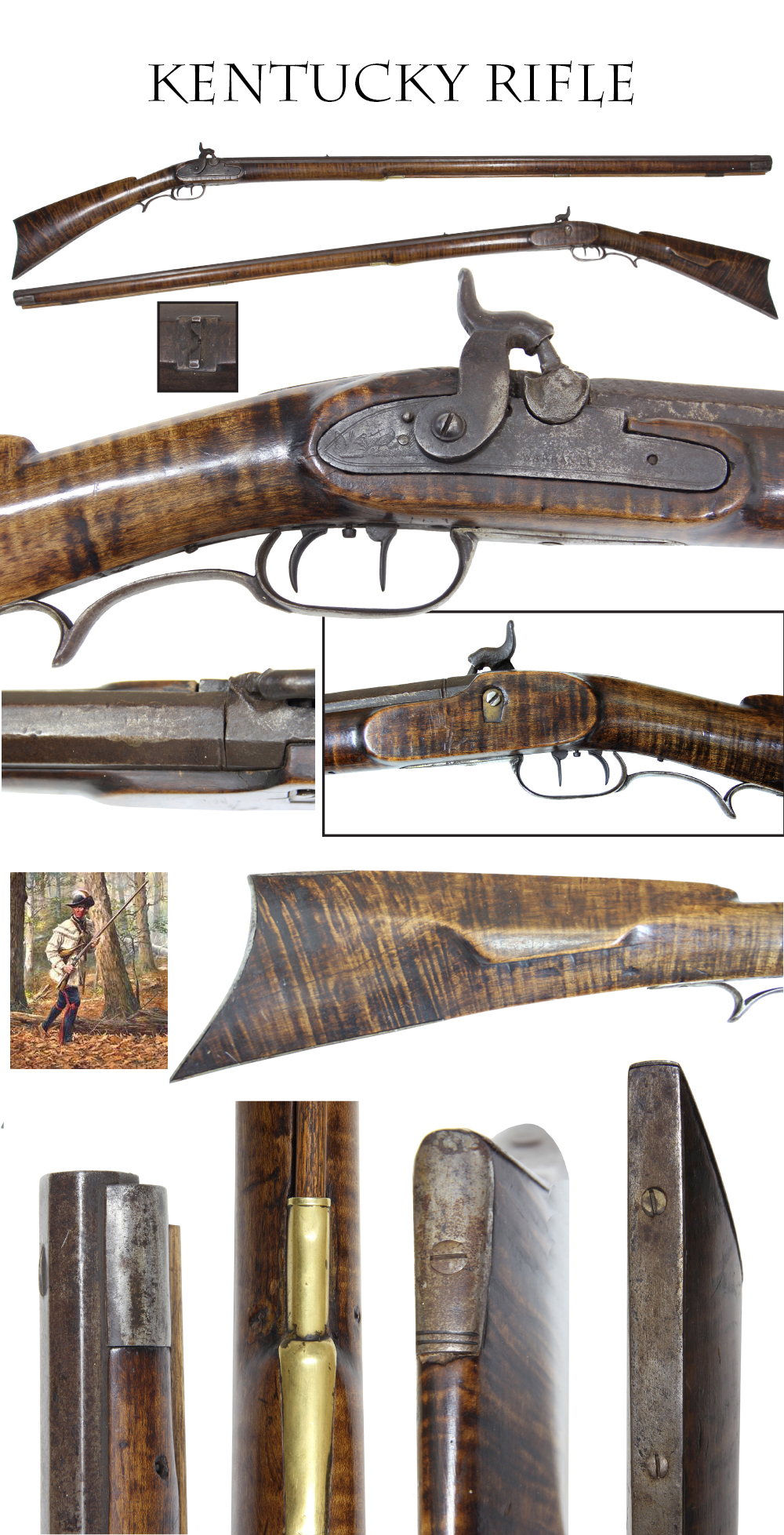
17-05-09… 45 CALIBER “LONG TOM” DOUBLE SET TRIGGER KENTUCKY RIFLE… This is a mighty long old rifle gun… 45 inch barrel and 59 inches overall length. Bore is 45 caliber with crisp rifling that looks like it will polish to excellent. This is a very nice full-stock percussion iron mounted Kentucky rifle. Raised cheek rest on the left side. Nice drop to the butt. Warranted commercial lock with single lockscrew and tombstone brass washer on the offside flat. Double set triggers. Triggerguard with hand rail. Slight shrinkage around forward end of lock. Rather crude percussion bolster. Some dings to the metal around the breech, otherwise very good. No barrel marks. Rear sight and front sight in place. Front sight showing some wear. Brass ramrod thimbles and iron nose cap, triggerguard and butt plate. Stock has very nice tiger graining overall. Overall very handsome showing just a few handling dings. Ram rod replaced. . The double set trigger lock needs a tune up. The spring is fine. When I try and “set” the trigger by pulling the back trigger it will not hold. I am certain it is an easy fix but I don’t have the time to work on it this week and will leave it for you. A very pleasing frontier rifle … $750.00
sold
Call us @ 419-842-1863

17-05-10…TIEMANN & CO. CAPITAL SURGICAL KIT… Classic Civil War period George Tiemann made and marked large size, three tier, capital surgical operating kit housed in a beautiful brass bound wood (mahogany?) case with deluxe wood grain. Red lining to the case is in very good condition with the black and gold oval Tiemann maker label in place on the lid to the upper tray. The label bears the 67 Chatham Street N.Y. address which Tiemann worked at starting in 1863/1864. The major tools are present and Tiemann marked: the saw, tourniquet, Hayes saw, brush, large scalpels and knives. The trays show only a few tools are missing, scissors, forceps, catheters, tweezers. These pieces can be purchased on the internet. I am selling it exactly the way I got it. The escutcheon plate for the keyhole is missing and could be replaced. Overall this is an impressive casing and would look great in a Civil War medical display. Tiemann was in business in New York City from the 1830s. Take a look in Dammanns several volumes on CW medical instruments for similar examples. There are a lot of smaller kits out there for dissection, etc., this one is a real surgical kit for amputation, etc., and a telling reminder of the hardships a Civil War soldier might face at the hands of the saw-bones. $3,250.00
sold
Call us @ 419-842-1863

17-05-11… WISCONSIN? SOLDIERS WALLET WITH 1863 DIARY AND SOLDIERS HYMN BOOK…
Nice lot of personal items. Bluish green leather wallet with brass clasp. Purple cloth interior pockets with white trim, and short leather pockets marked Postage and Tickets (for the railroad, etc.) Condition excellent. With this comes a damaged soldiers hymn book and 1863 diary that is filled in nearly every day and includes some battle content as well as camp life, etc… Here is a sampling…. March 23rd Out on the skirmish duty about a mile and ? detailed… soon a line of battle is formed on our rear and ??? Lines pass us as cannonading commences and our line falls back. We form a line and march to the left flank. March 24th Go and see fort. Also up on ridge and see ? and gun boat. 4 killed from 29th Wisconsin. Rebs had a slaughter yard after dark. Ordered out to breast works we built on the 26th. March 25th Co K ordered out on picket. Stationed with others. I wrote to sarah and Aunt M…. Heavy musketry from about midnight at front. Learned since that rebs tried to take one of our boats. There is a wealth of entries. The covers of both booklets are gone, but they display well with the wallet and they came together, so I am keeping them together. A little reserach will definitely uncover the unit from which this soldier served. Nice example of a soldier’s personal effects and the type of ephemera usually carried but seldom preserved. $650.00
sold
Call us @ 419-842-1863
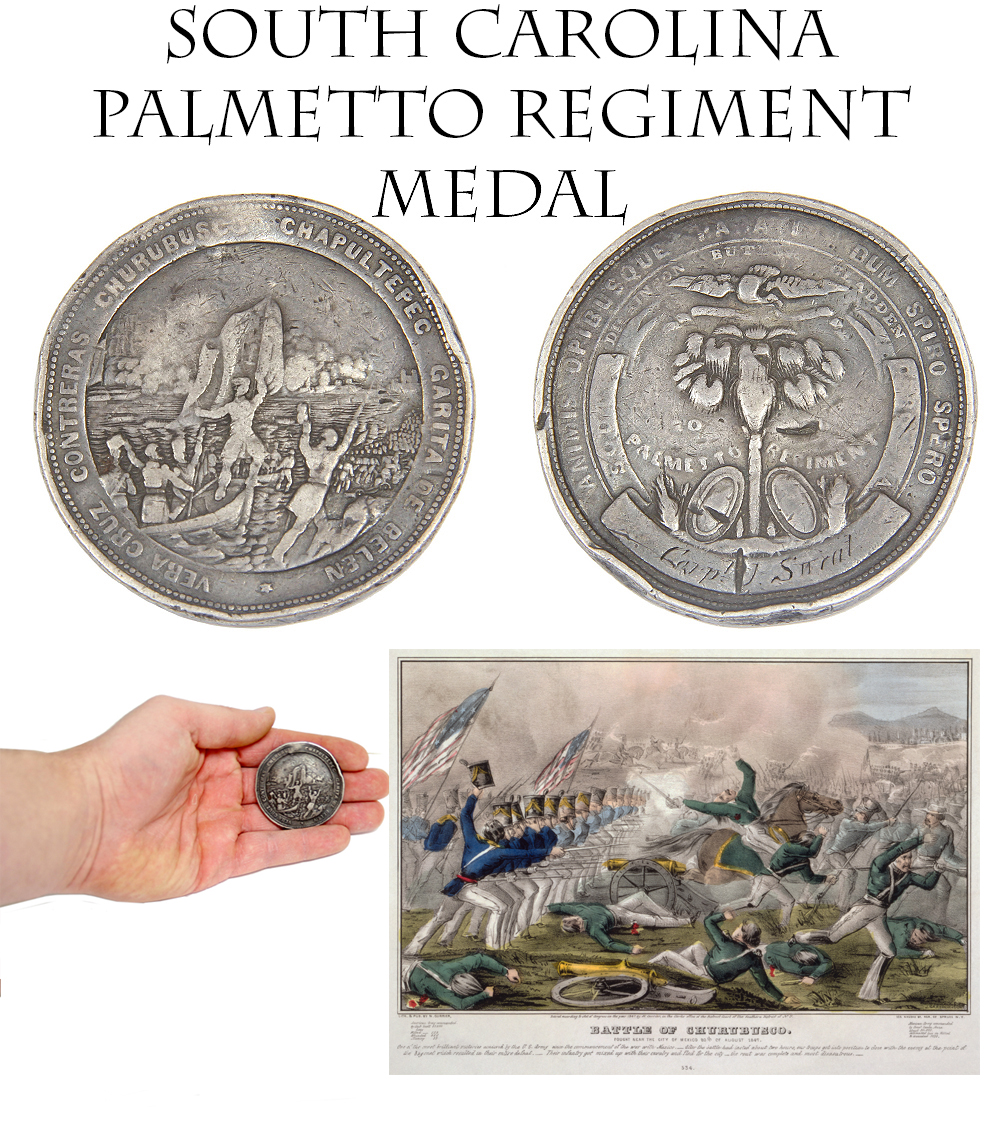
17-05-12…EXCEEDINGLY SCARCE SILVER SOUTH CAROLINA MEXICAN WAR PALMETTO REGIMENT MEDAL INSCRIBED TO CORPORAL JOHN SWEAT OF COMPANY K…
The South Carolina House of Representatives authorized distribution of these medals, gold for officers and silver for enlistedmen, in late 1848 and they were distributed in 1850. William Glaze, well known to Civil War collectors, was first touted as the engraver, but the work was eventually done by William Keenan and the production of the medals was entrusted to Gregg, Hayden & Co. The Charleston Courier described the medal as follows: On one side is represented the landing of the American troops at Vera Cruz, the gallant leader of the Palmetto Regiment, Colonel Butler, having sprung from the boat that bore him to the shore, and with drawn sword, is calling on his command to followa figure, bearing the beloved Palmetto Flag, is on the prow of the boat, about to leap on shore, and plant the Standard, around which all appear eager to rally. To the right, are serried columns of troops on the line of march toward the Castle at San Juan; while in the distance is seen the American fleet, covering the landing of more troops, which are approaching the shore in boats. Around the edge of this side of the Medal, in raised letters, are the names ‘Vera Cruz’, ‘Contreras’, ‘Churubusco’, Chapultepec’, ‘Garita de Belen’ On the reverse, is delineated a beautiful Palmetto Tree, resting against the trunk of which recline two shields, bearing the dates ‘1846’ and ‘1847’. Hovering over the tree is a spread winged eagle, from whose beak floats the motto of the Union, E Pluribus Unum, immediately above which, in a circle, is inscribed the names of ‘BUTLER’, ‘DICKINSON’, and ‘GLADDEN’. On the outer rim are the State mottos, ‘Animus Opibusque Parati’ — ‘Dum Spiro Spero’. In the centre of the medal in curved lines, are the words To the Palmetto Regiment, and at the foot and lower edge is the scroll, for inserting the name of the recipient. Our medal is engraved Corpl. J. Sweat in the scroll and there is only one candidate: John Sweat of Company K, commanded during the war by Walker and OBannon. The company was organized in 1846 in the Barnwell District, later Barnwell County. The officers named on the medal were the field officers of the regiment at Churubusco, two of whom were mortally wounded carrying the regimental colors. At the Belen Gate at Mexico City the regiments flag was reportedly the first raised over the captured works. John Sweat shows up as a private on the roster of Co. K, Walker and OBannons company, organized in 1846 in the Barnwell District, SC. He survived the war, though a Paul Sweat in the same company did not, dying November 2, 1847 at Puebla. A relative of our man? Our hero apparently had died by 1899, for he does not appear on the list of survivors compiled by private John Cantwell of the regiment in that year. There are some dings to the edges of the medal, some expected wear to the high points, small scratches and one small gouge between corpl and J. Sweat that does not affect the text or design elements. This is a very, very scarce early American military medal from a fighting regiment in the Mexican War and there is potentially a load of other research waiting to be done on the soldier. Ive seen a few of these in Mex War displays over the years, but this is the first one I have personally owned…
$1,750.00
Call us @ 419-842-1863
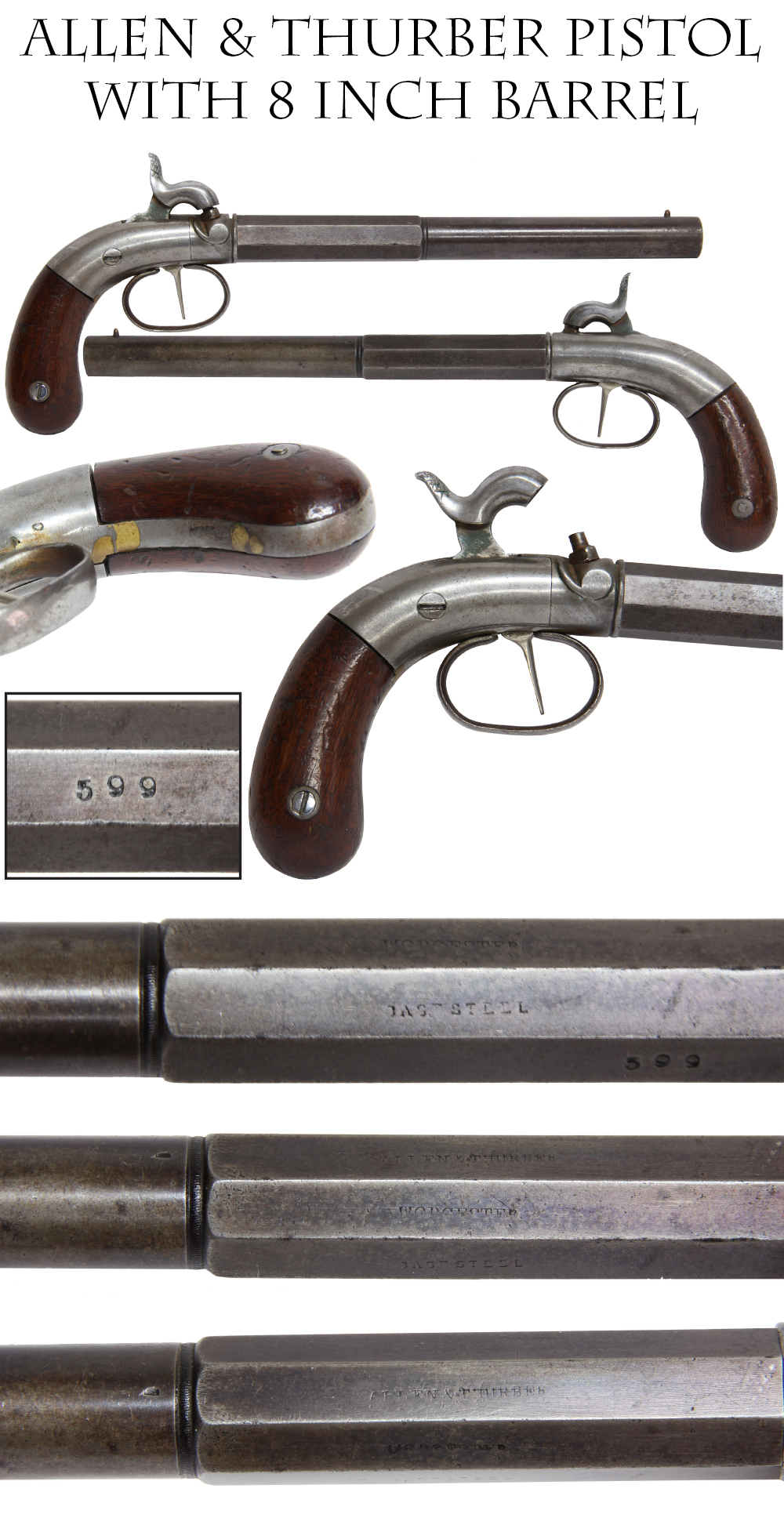
17-05-13… ALLEN & THURBER BOOT PISTOL WITH 8-INCH BARREL… The second of two Allen & Thurber center hammer pistols on this list. Long barrels are sought after on these pistols and this one has an even scarcer 8-inch barrel. As with our first example, this one shows good edges and visible markings. This also has the standard Cast Steel stamping on the barrel flat along with Allen & Thurber, Worcester, and a serial number 599 showing just some slight wear. The frame is smooth bright metal. The trigger is replaced. The hammer is repaired. Otherwise original. The bag shaped grips show just minor dings. Mechanically very good.
$385.00 sold
Call us @ 419-842-1863
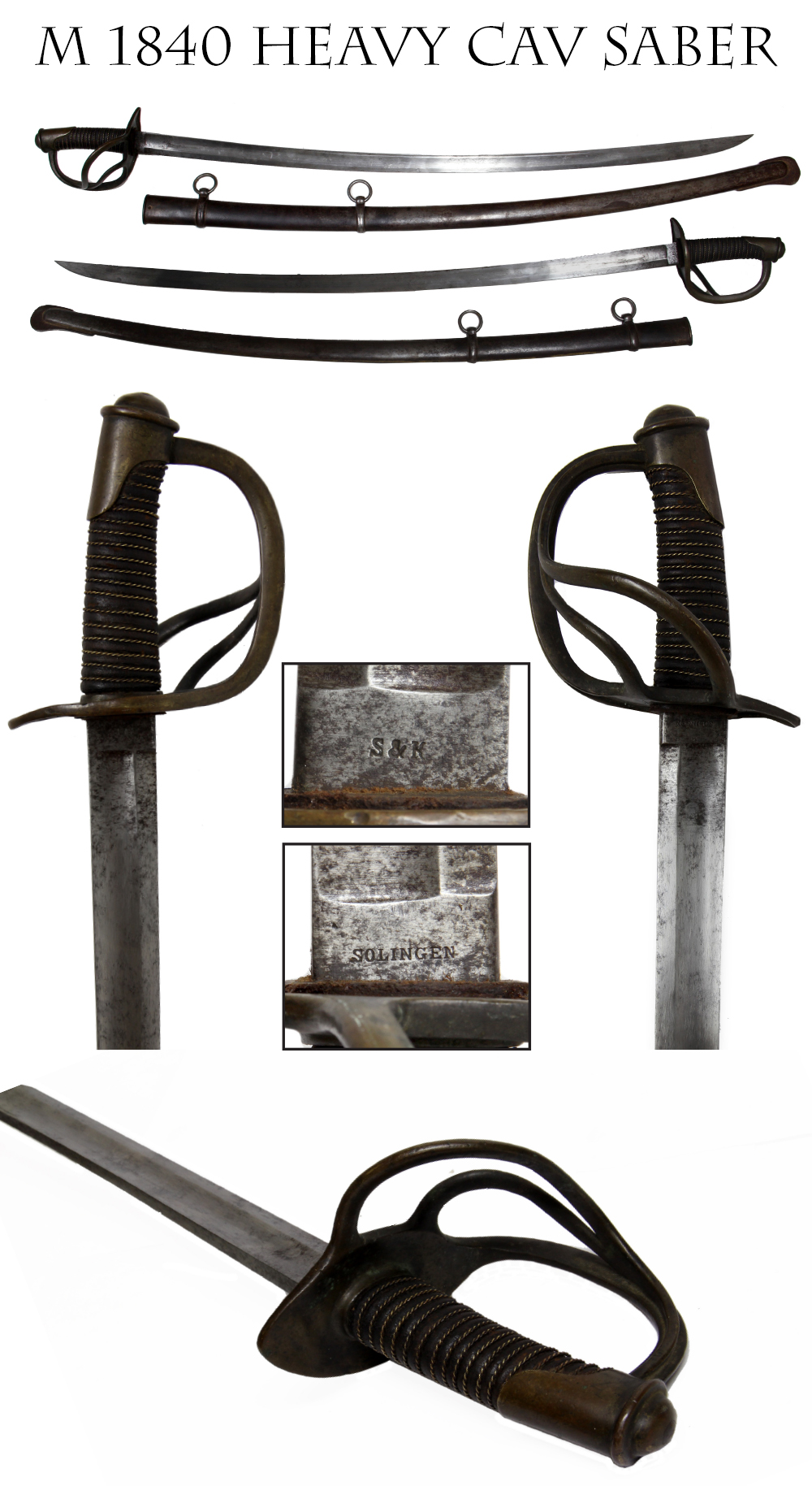
17-05-14..M1840 HEAVY CAVALRY SABER… Schnitzler and Kirschbaum supplied edged weapons to the US military very early. In fact, their 1840 pattern US cavalry and artillery sabers made their way into the hands of US troops in the Mexican War and early plains wars when US firms could not tool up in time to supply the government with the new patterns. They were also major suppliers during the Civil War. This is one of their wartime sabers with their “S&K” mark on one side of the ricasso and “Solingen” on the other. The brass hilt has a magnificent undisturbed deep bronze color agedpatina and the leather and wire of the grip are original showing light wear. The sword even preserves the leather pad at the blade shoulder. The blade has a nick-free edge and undamaged point and shows a dull silver overall with gray and brown spots. The scabbard has the throat, drag and rings in place and no major dents. The rivet at the throat is missing. These 1840 pattern sabers were hefty weapons and merited the nickname “wristbreaker.” A real no-nonsense combat weapon imported in large numbers to arm the suddenly expanded Union cavalry. $495.00
sold
Call us @ 419-842-1863
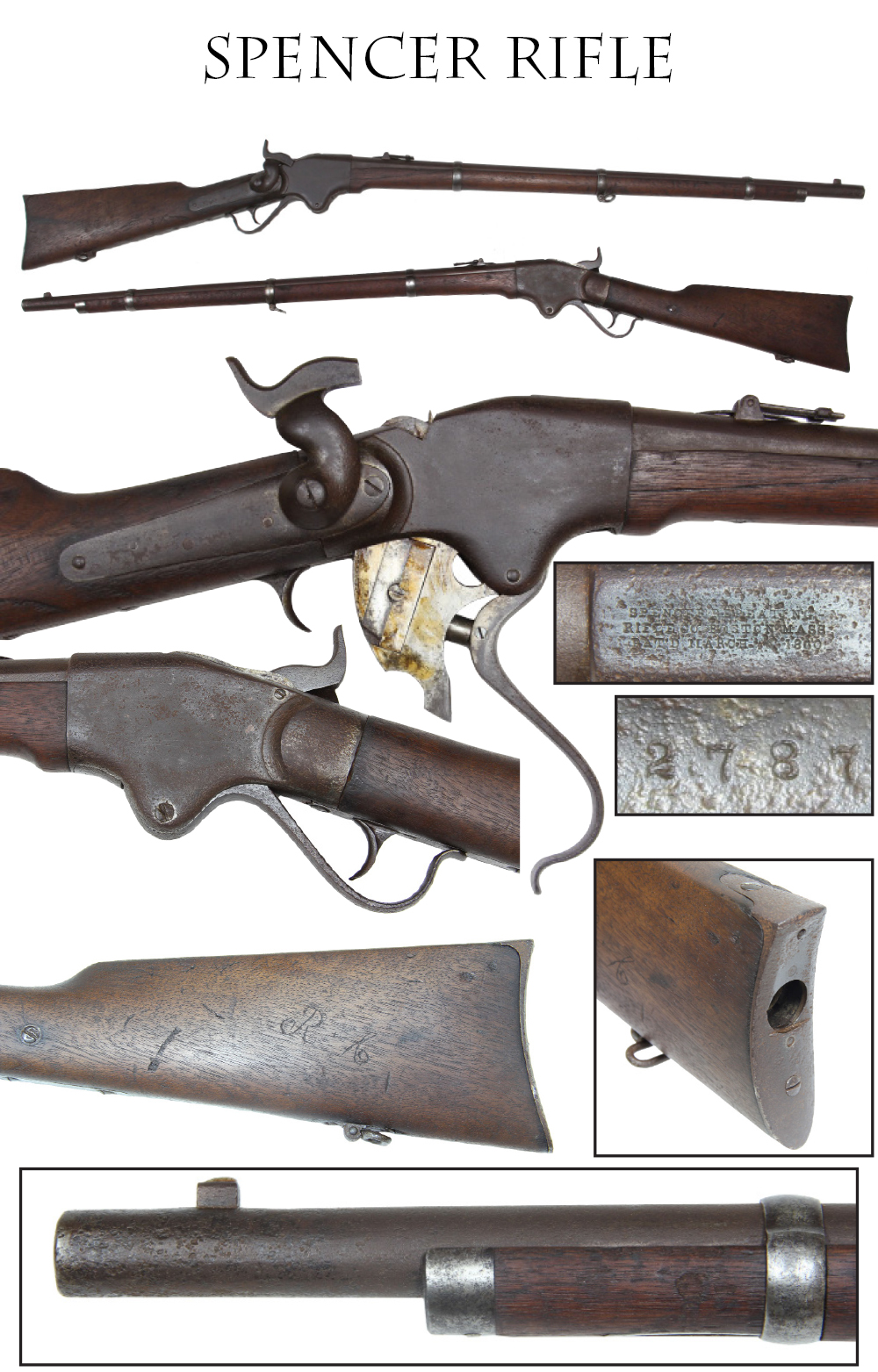
.17-05-15… LOW SERIAL NUMBER M1860 SPENCER RIFLE…..No introduction necessary here: the dreaded Yankee horizontal shot tower. Low serial number, #2787 making it a pre-Gettysburg gun. The carbine version of Spencers seven-shooter did not get issued until the Fall of 1863. Before that, both cavalry and infantry lucky enough to get them were issued the longer 3-band infantry rifles. This one shows the usual dings and scratches of a real field-used arm, but the wood to metal fit is tight and the mechanics are good. A light pair of initials, RC are scratched into the left butt flat. The forend shows a narrow, stable crack. The metal is a mix of dark gray and brown, with overall shallow salt and pepper pitting covering the frame and barrel. Maker and patent information and serial number are visible. Sights and swivels are in place. Bands and nose cap are present and show a bit lighter. The magazine tube is long gone, but could be replaced. I dont have one handy, but they show up from time to time. Wood shows a tight fit to the frame both of buttstock and forestock. Forestock shows a narrow stable crack forward of the receiver. This is a good early example of a Spencer dating before Gettysburg and within the first few months of production. Exactly what Custer’s boys carried at Gettysburg, and exactly the rifle that Wilder’s Lightning Brigade carried. Shows its age, but the real McCoy and solid. $1,950.00
sold
Call us @ 419-842-1863

17-05-16…Extra Fine Condition 1863 Springfield Rifle Musket: This is a wonderful Model 1863 type-1 musket in NRA excellent condition not mint but not far from it. Truly an investment grade musket. The steel is bright with sharp edges and crisp markings. The stock is likewise superb with minty edges and crisp cartouche stamps including the ESA mark of Erskin S Allin the master armorer at Springield armory. It is dated 1863 on the lock and 1864 on the barrel, indicating that is was likely made early in 1864. The stock has the screw tightened friction bands of the type-1 model. The bore is in extra fine condition. The lock retains generous amounts of case color. This is one of the nicest examples of this musket you are likely to find. A super musket at a super price $2,750.00 sold
Call us @ 419-842-1863
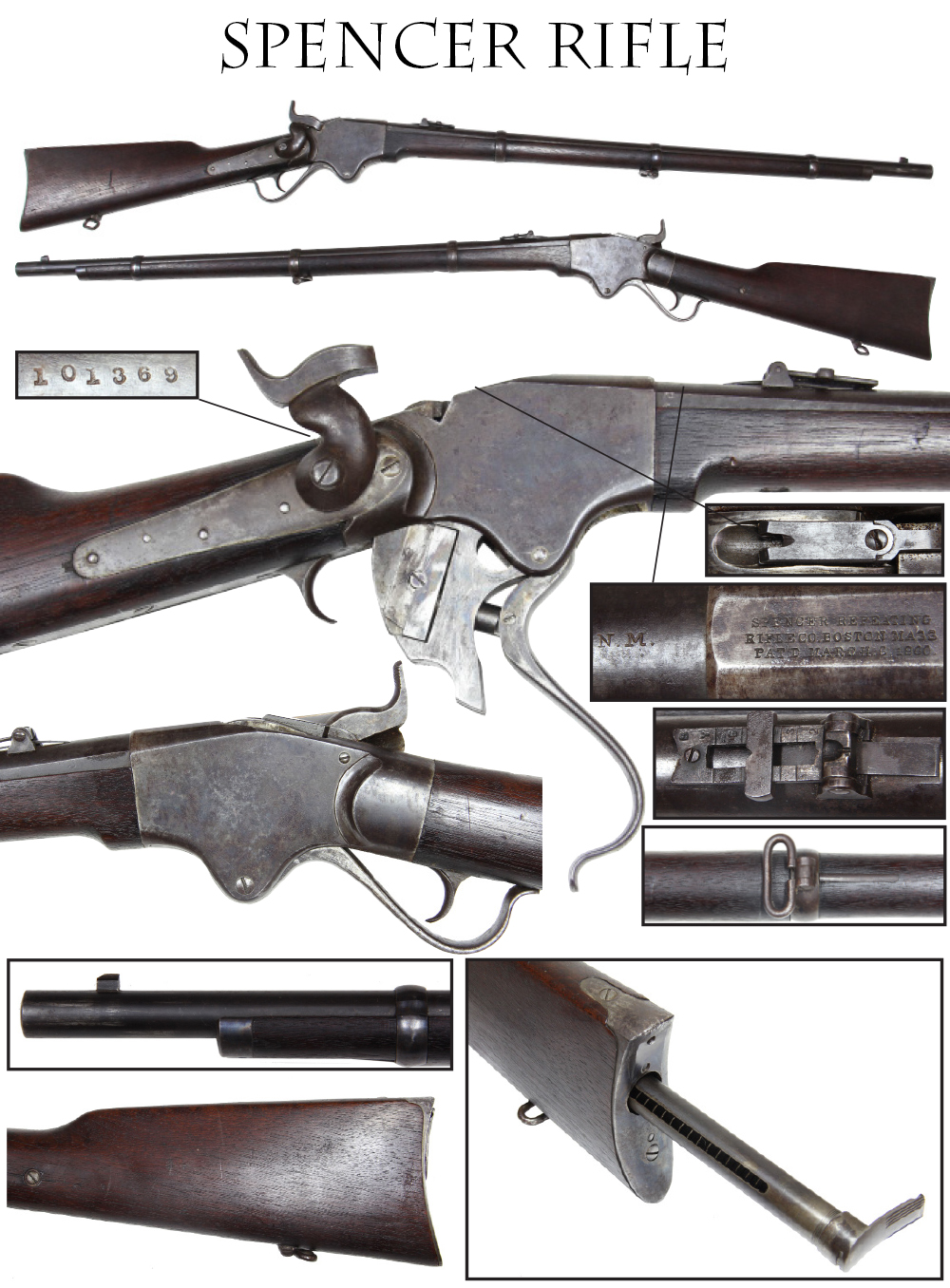
17-05-17… SCARCE NEW MODEL SPENCER RIFLE FOR INDIAN WAR SERVICE… A sharp condition Spencer New Model rifle, serial number 101369. These scarcities were made circa 1868 and were .50 caliber, like the model 1867 carbines, and use the Spencer patent magazine cut-off mounted on the top of the breechblock rather than the Stabler patent toggle near the trigger. This one is near fine condition. It has crisp numbering, maker and patent stamps. The barrel is smooth metal with lots of original blue turning plum, and muted case colors on the frame, shifting toward a cloudy gray on the lock plate. Tight fit of wood to the metal. Sights, bands, swivels and magazine tube in place. Mechanism good. Correct N.M. barrel marking forward of receiver. A very nice example of a scarce version of the Spencer. Flayderman estimates only 2,500 were produced. A dandy top shelf example of a very scarce martial repeating rifle. $2,450.00
sodl
Call us @ 419-842-1863
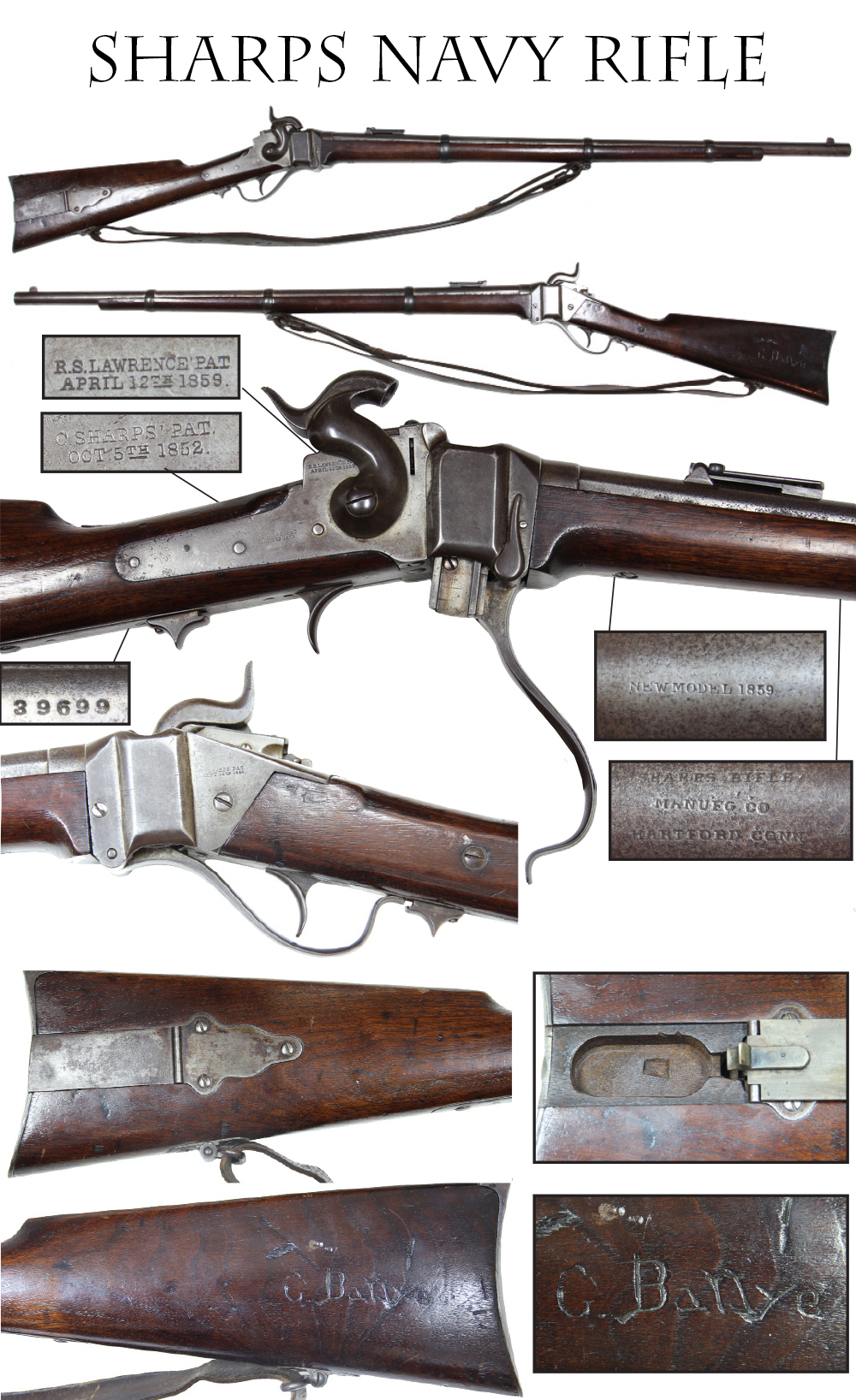
17-05-18 NEAR FINE CONDITION SHARPS 3-BAND NAVY RIFLE WITH NAME: One of the scarce variants of the famed Sharps is this Civil War Model 1859 military rifle made by the Sharps Rifle Manufacturing Company of Hartford, Connecticut. This is the 56 caliber navy model for which Sharps contracted to supply only 2,780 rifles. This straight breech, .56 caliber model was part of the Navy contract and is equipped with the bayonet lug under the muzzle. The rifles serial # 39699 is located on the frame tang. It features a 30 long round barrel mated to a black walnut stock. Markings are crisp. Barrel bore is very good with strong six-groove rifling. The barrel is fitted with the bayonet lug under the barrel. Stock features an iron patchbox and a full forend stock that is secured to the barrel with three-barrel bands. 100% original, 100% complete, and mechanically perfect. Carved into the stock is “G. BATTYE”. The surname is highly unusual. Of some note is that there is ONE sailor listed with that last name in the navy rosters, with a different first initial. I will wager he bought the rifle when he went home and his son carved his name into it. I note my friends at the Horse Soldier Shop in Gettysburg show they sold one for $5,950.00 on their web site. Here is one in MUCH stronger condition with a researchable family name, and part of an original sling… $4,250.00
sold
Call us @ 419-842-1863

17-05-19…WELL USED 1860 SPENCER CARBINE… The quintessential Yankee cavalry carbine, an 1860 Spencer carbine. The seven-shot Spencer was a robust weapon that gave Federal cavalry some impressive firepower. This one shows numerous dings to the wood, indicating some active field use, but is still a very respectable example. Smooth metal with clear, legible Spencer marking on the top of the receiver and serial number 55697. Barrel has deep brown patina. Receiver is a mix of pewter and gray with some light brown.
Sights, sling ring and butt swivel in place. Rear sight lacks tiny retaining screw on the ladder. Small “x” carved at rear of forend on either side. Narrow, stable crack at top of wrist and on either side of the buttstock at the magazine tube, which is pretty standard. The magazine tube is in place. A well-used, honest example, priced right.
$1875.00
Call us @ 419-842-1863

17-05-20…OHIO MARKED BRAZILIAN LIGHT MINIE RIFLE… One of the most attractive of the percussion rifles used during the American Civil War. The Brazilian Light Minie Rifle was manufactured by the O.P. Drissen Company of Liège, and was a unique combination of the features found on the British Pattern1856/58/60 series of Enfield short rifles and the French Light Minié rifle. This .577 caliber rifle was designed to accept a straight bladed saber bayonet, and the guns imported by US purchasing agents are readily identifiable by the classic brass shield with an eagle on the wrist of the stock. The guns have the OP Drissen maker mark of a D/Anchor/C on the lock and most of the metal parts, typically the breech, lock, butt plate, barrel bands and trigger guard of the guns. This same mark also appears on the obverse ricasso of the saber bayonets that were manufactured by Schnitzler and Kirschbaum for use with the rifles. The US Government purchased around 6,000 of these rifles and if my memory serves me, the brass eagles were added in Cincinnati, Ohio. The story goes that these Belgian made guns were part of a contract destined for the Brazilian military, but ended up being sold to US buyers instead. From time to time, these guns also show up with state of Ohio ownership marks, and this happens to be one of those scarce examples and is one of the most crisp examples I have seen. The wood has good edges and color with just minor handling marks. The Ohio stamp is deep and sharp. The metal is in the bright, with a mix of silver gray and pewter on the barrel and faint mottled case on the lock, just some slight light pitting below the bolster. The brass has a medium patina with a faint mark on the buttplate tang I can’t quite make out. The bayonet lug has a mating number for the bayonet: 4935. (I may have a bayonet correct for this rifle. If so price is $200.) Sights, swivels and correct rod are in place. Mechanism is good. A crisp example of an attractive two-band rifle. Scarce in this fine condition.
$1,650.00 sold
Call us @ 419-842-1863

17-05-79…. FIRST MODEL MERRILL CARBINE… These breechloading, .54 caliber, Baltimore-made carbines were pretty popular, being issued to the 1st, 5th, 18th NY cavalry; the 11th, 17th, 18th Pennsylvania, and other units. Flayderman says that some 14,495 were produced during the war. Many were produced before the war and were used by Virginia confederates. I have owned two 100% documented Merrill’s carried by Virginia Confederate troopers A hinged loading arm raises up on top and draws back a plunger allowing insertion of a cartridge and rams it tightly home when closed. This one is serial number 9942 and follows Merrill’s first type in having a brass patchbox and serial number at rear of lockplate, but with a beveled lockplate and second-type button head latch on the breech lever. Clear Merrill patent stamps on the lockplate; visible but slightly rubbed on top of the lever. The lockplate shows faded mottled case colors. Some chips out of the forward edge of the lock platform and some handling dings on the offside under the sling ring bar and two dings just aft of the barrel band on the right. Wood has a tight fit to the metal. Barrel shows a dull, pewter gray. The loading assembly shows some rubbing to the patent stamp and one small patch of shallow pitting, but muted, but visible, case colors. Nice mellow patina to the brass mounts. This has the first pattern brass patch box as well. A classic Civil War cavalry carbine with nice, sleek lines and good looking brass mounts. Perfect for display with US or CS effects. $1,975.00
Call us @ 419-842-1863
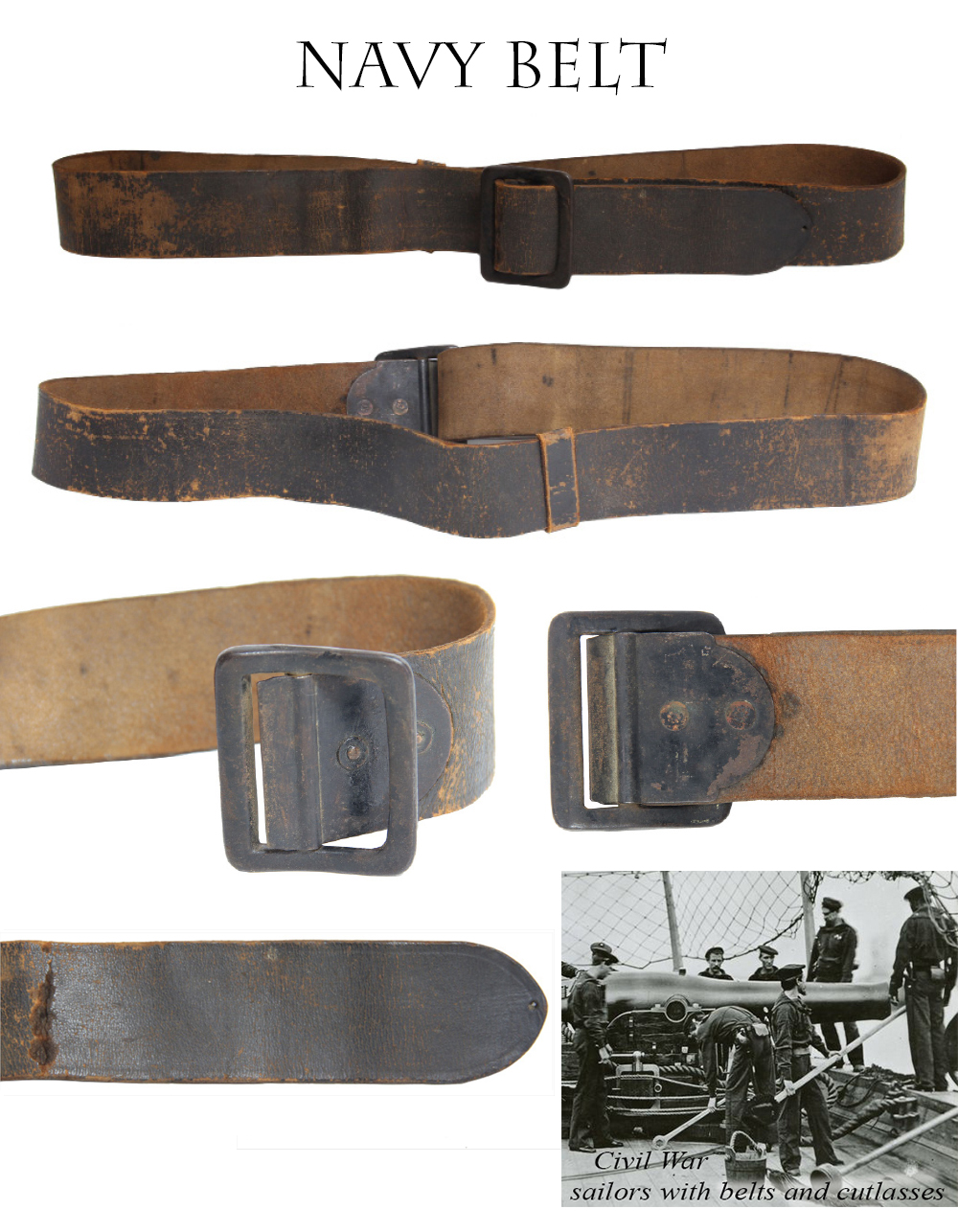
17-05-80… ENLISTED NAVY BELT… This is the 1862 pattern of seaman’s belt that replaced the old brass hook and standing loop design with a Goodyear patent friction buckle. These belts are very simple and very, very uncommon. They were made in buff and in bridle leather, as this one is. The belt has good color and is flexible, with some scattered wear spots from abrasion. There is one weak spot, shown in the photo, where the belt had been left in the buckle and partially cracked where the bar crossed it. This could be concealed pretty easily, but I have left it as found and it displays great in any case. Sailors wore these to carry cutlasses, pistols, cartridge pouches, etc. as part of landing parties, but also on gun crews in expectation of either boarding an enemy or being called upon to repel boarders. A scarce regulation Civil War navy accoutrement belt. $495.00
sold
Call us @ 419-842-1863

17-05-81… WHITNEYVILLE RIFLE MUSKET… A wonderful example of Yankee Ingenuity “Whitney Style”. Whitney had a sort of “spaghetti against the wall” approach to arms supplying. His muskets often used odd parts he gleaned from a variety of sources, including the US Arsenals. This musket is a Springfield M1863 which has been married to a Whitneyville M1861 lock, with the M1861 hammer severely canted to properly strike the nipple. I have no idea whether Whitney or another arms seller sold this “good and serviceable”… I will leave that bit of detective work for you. When Whitney obtained a second US contract in October, 1863, for 15,000 1861 pattern rifle muskets, his first guns had been sitting around from the earlier contract and the remainder, true to form, show a number of variations. This is a good example of the second pattern of lockplate markings he used, a more conventional eagle and US with “Whitneyville” forward of the hammer and a vertical 1864 date at the rear. The barrel, however, shows an 1863 type bolster with no clean-out screw and stamped with an eagle, and the bands are the round 1863 style. These parts appear to be ex Springfield Arsenal. Metal shows some light peppering near the breech and on the bolster from firing, but is generally smooth and light silver-gray in tone. The lockplate shows a mix of gray and pewter that are the remains of case. The lock markings are crisp, though the bolster eagle shows peppering and the tip of the hammer is a little crusty. Sights, bands, springs and swivels in place. No rod. Short range sight leaf is replaced. Sharp V/P/eagle barrel proofs. Wood is very good. Very slight rounding and a few light wear marks. No significant dents or divots. A little crustiness to the buttplate heel from standing upright on a floor. A classic Civil War long arm and from a famous American gunmaker who is a collecting field unto himself… $875.00
Call us @ 419-842-1863
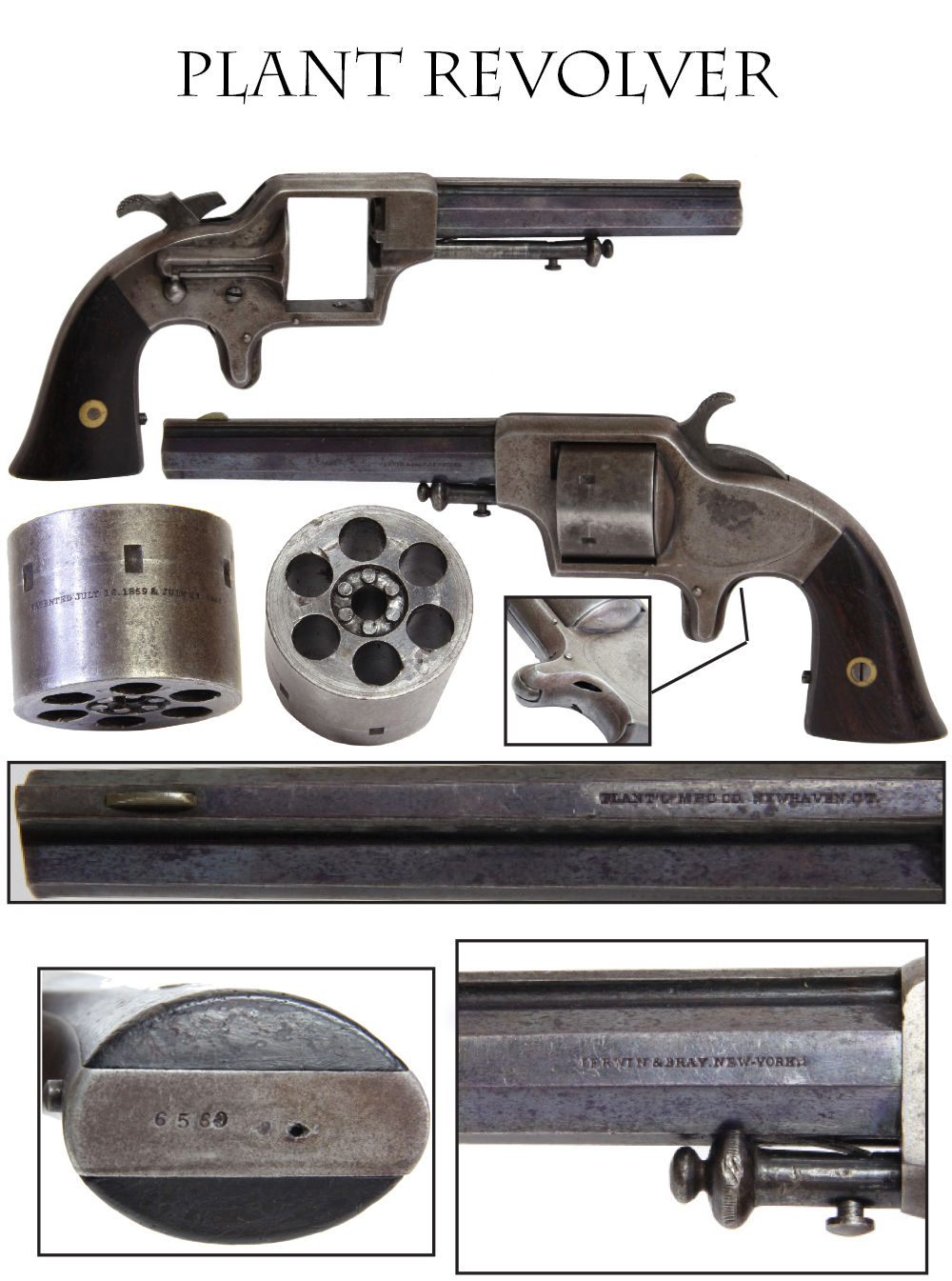
17-05-82… LARGE PLANT ARMY REVOLVER… Much nicer than shown in these JPGs. The barrel has 60% vivid blue that the camera man didn’t capture. Very rare, iron frame version of the Third Model Plant “Army” revolver. Flayderman notes that of some 7,300 hundred third models, most were brass framed: “A few known with iron frames in the 6500 range; very rare; worth premium.” Plant used a cup-primed .42 caliber cartridge in these revolvers that loaded through the front of the cylinder in an attempt to get around the patents for bored-through cylinders controlled by Smith and Wesson. He also provided exchangeable cylinders that could fire standard percussion pistol cartridges. No government contracts are known, but they were popular sidearms. Frame shows a dull gray patina mixed with thin brown. Grips are very good, with a tight fit. Plant barrel address shows a bit soft at the edges in the strike. Merwin and Bray were the financiers and agents for these pistols. Their stamp on left barrel flat is crisper, though weak on the “M.” Serial number is 6569, in the proper range for this variant. Cylinder patent stamps are crisp. Mechanically very good. Ejection rod present. I see what seem to be two small forging flaws on the rear of the spur trigger housing and one on the bottom of the buttstrap. A very, very scarce variant of this popular pistol. $850.00
sold
Call us @ 419-842-1863
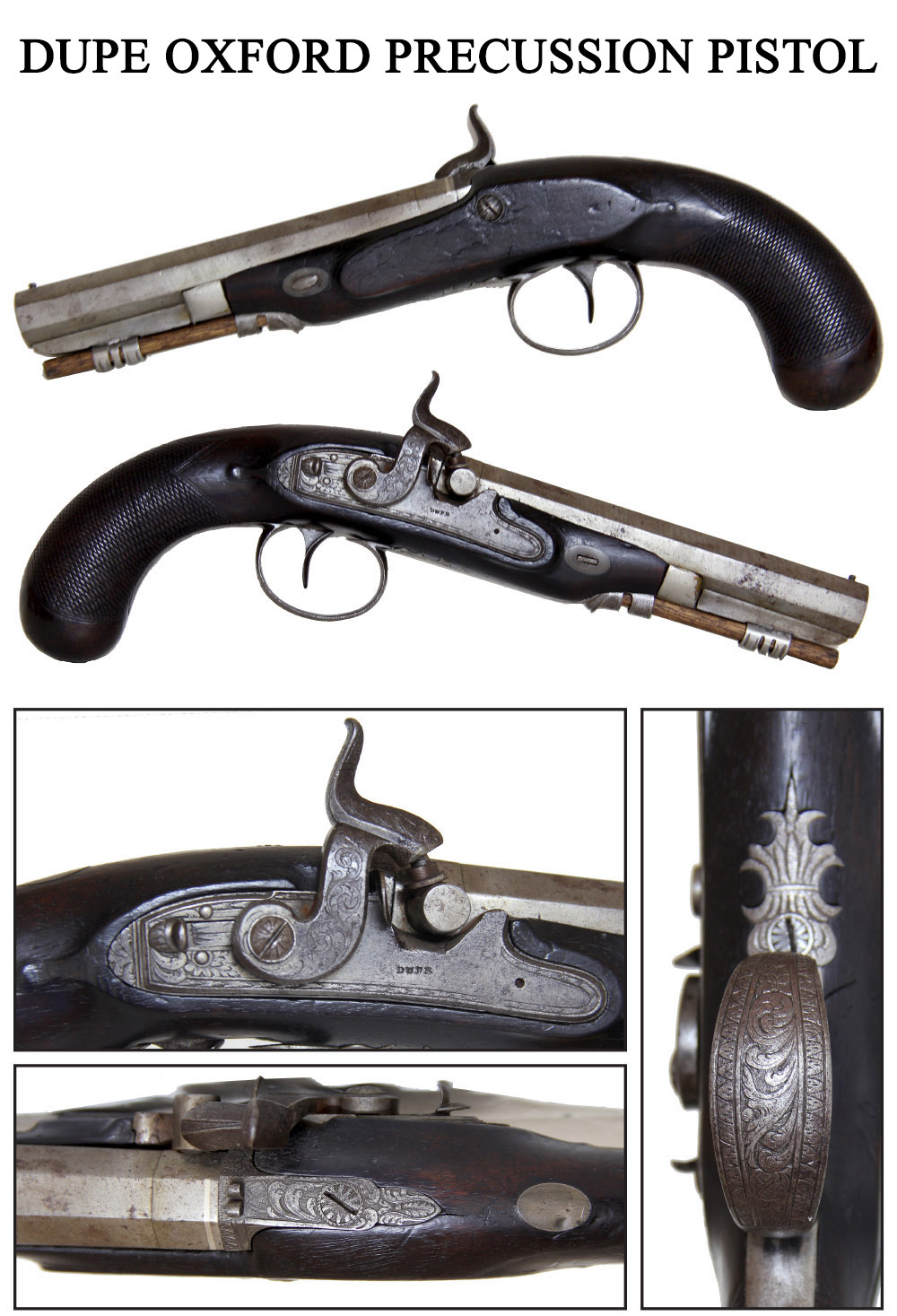
17-05-83…. W. DUPE OXFORD PERCUSSION PISTOL … Nicely engraved single-shot large bore .52 caliber percussion pistol converted from flintlock, signed DUPE. This being William Dupe of Oxford, England. He worked 1810 – 1830. In the catalog / inventory of the renowned A.F. Brooks collection, a pair of pistols (listed as items 121 and 122) are listed marked DUPE and are classified as being from Petersburg Virginia. Assuming the same maker, it is interesting to see that Dupe shipped to Southern Virginia. Profuse floral engraving on the trigger guard, breech plug tang, and hammer. Border lines and some floral details on rear of lock plate. Sliding bolt safety to rear of hammer. Flash guard behind the bolster is likely the one present during the flintlock era. Oval thumb piece. Checkered round grip, half stock with single key and german silver forend cap. Larger round trigger guard is reminiscent of a dueler, but the barrel length suggests a traveler’s weapon. Octagon six inch barrel is light silver in color with a small patch of gray on the left flat just aft of the front sight. Ramrod is a crude replacement not worthy of this nicely detailed pistol. If I kept it I would improve the rod. In 2011 at Bonham’s Auction in England a cased pair of very similar Dupe pistols brought over $8,000.00 US (5,625 British Pounds). Here is a link that you can copy and print into your location bar if it does not show up as an active link …
https://www.bonhams.com/auctions/19002/lot/530/….Here is a lonely singleton priced like a red haired orphan… cjj-17067… $450.00
sold
Call us @ 419-842-1863
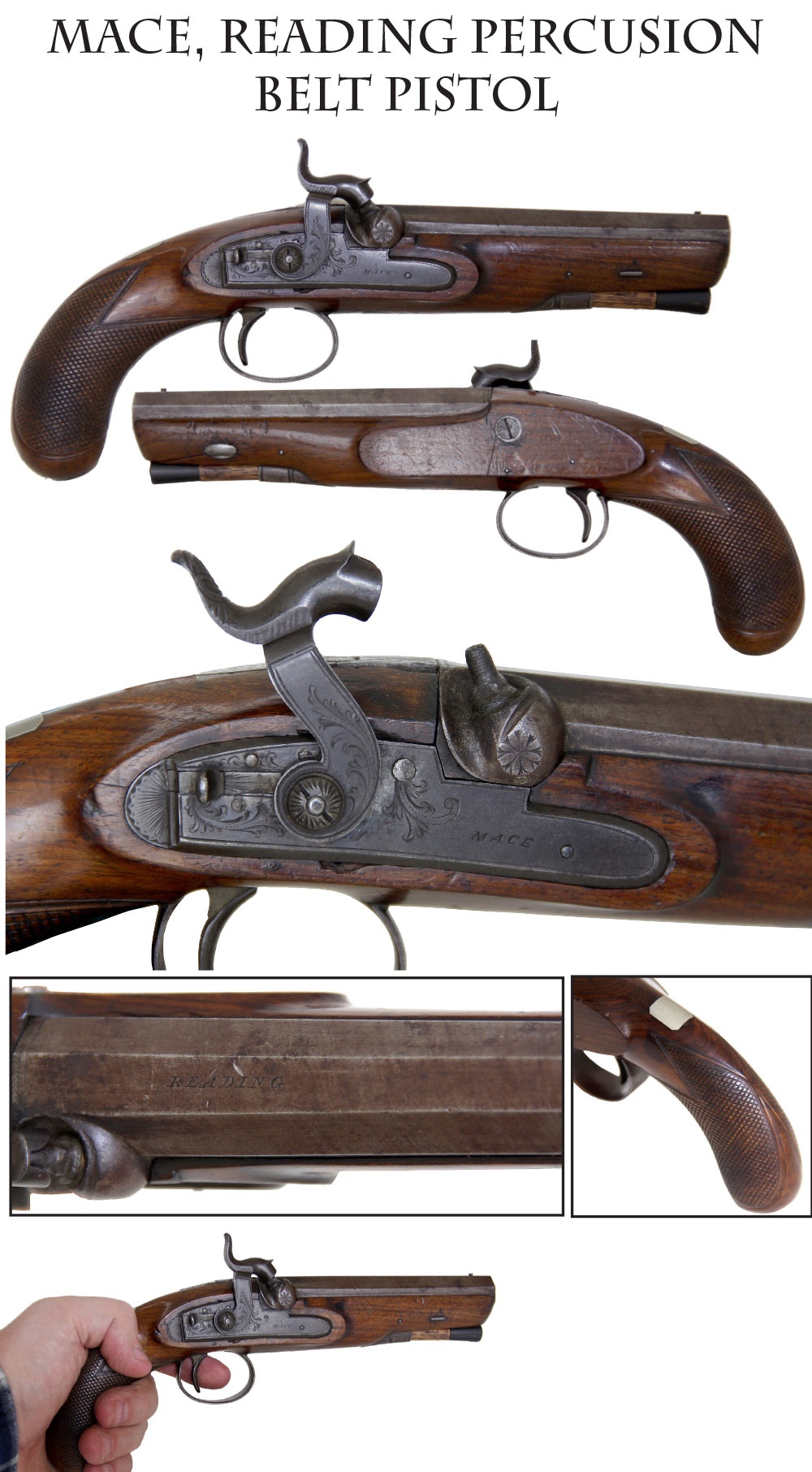
17-05-84… MACE, READING, PERCUSSION PISTOL … Large bore percussion single shot pistol by Mace of Reading, England. Elegantly engraved lock with sliding hammer safety. Lock shows a deep pewter color with no corrosion and the barrel is a faded blue turned light plum brown, showing traces of what was probably a faux-damascus bluing. Bag shaped checkered grips with a clipped-corner rectangular thumbplate in silver. Nicely engraved… Even the bolster and side screw are engraved. A couple of minor dings around the lock mortise, original(?) horn-tipped ramrod. These are often called overcoat pistols from their convenient size for carrying, but became popular as “coaching” pistols when the road system improved enough to permit travel by coach rather than horseback. Highwaymen were still a threat to travelers, and this pistol was a good defense weapon. Ca 1845. VG++ … noco… $695.00
Call us @ 419-842-1863
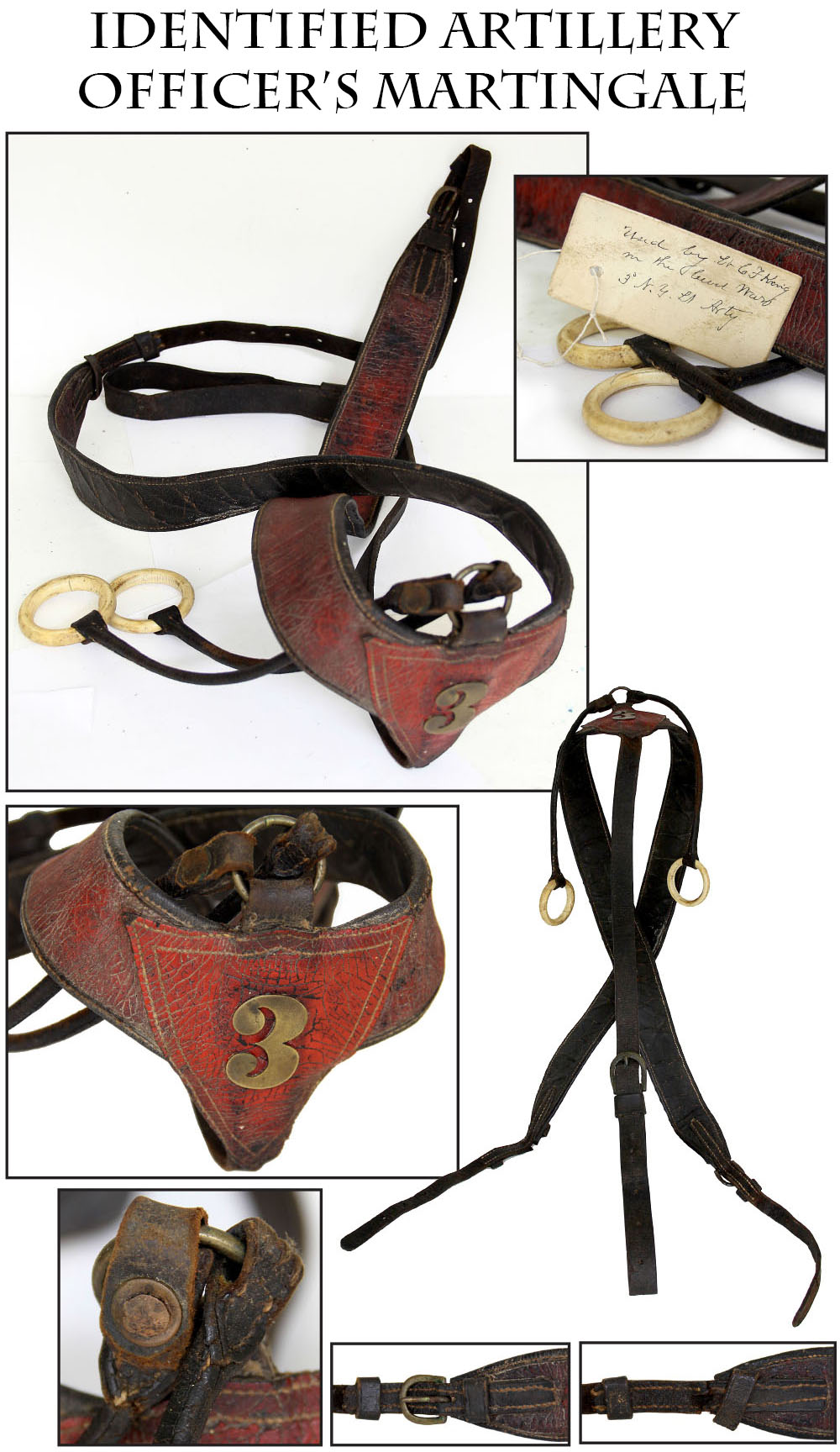
17-05-85… Rare Horse Gear! Identified New York Artillery Officer’s Martingale With Super Tag … Battle Service in Virginia and North Carolina … One of the most interesting pieces of horse equipment to present itself to me in recent years. An incredibly scarce piece of horse gear with a regimental numeral on the chest shield, red color to the leather for branch of service, and a dead real note identifying it: “Used by Lt. C.F. King /in the Civil War / 3d N.Y. Lt. Arty.” New York fielded both independent batteries of artillery and regiments of artillery. Most of the NY regiments were heavy artillery with the exception of the first and third regiments whose companies served as individual batteries. Charles F. King enrolled at age 21 on 10/17/61 at Lee Center for 3 years and mustered in as a private in Battery H 11/16/61. He made sergeant 1/9/62 and was commissioned 2nd Lieutenant 1/8/64 with rank from 12/3/63 and officially mustered in at that rank as of 12/4/63. He served until mustered out 11/24/64. During King’s service the battery served in North Carolina and Virginia as part of the Artillery brigade of the 18th Army Corps, seeing action on the expedition from New Bern to Goldsboro at Kinston, White Hall and other fights. In 1863 it saw action at Wise’s Crossroads, Gum Swamp, Swift Creek and other engagements, and in 1864 served in front of Petersburg and Richmond. The breast strap is in very good shape, really nice. One small loop has loosened on one side, and there is a period repair to one of the straps securing the bone rings that ride on the reins. The horseshoe shaped buckles are present and the red color of the breast band and of the central shield is quite strong. Prominently displayed is a large brass numeral “3” on the shield panel for the Third NY Artillery. This is a very showy piece that would look great in an artillery display or any collection of mounted gear. We see post Civil War examples, or examples of undeterminable age every so often. But finding one that is absolutely Civil War and identified to boot is pretty darn rare. I do not recall the last time I saw an identified example on the market … $2500.00
Call us @ 419-842-1863
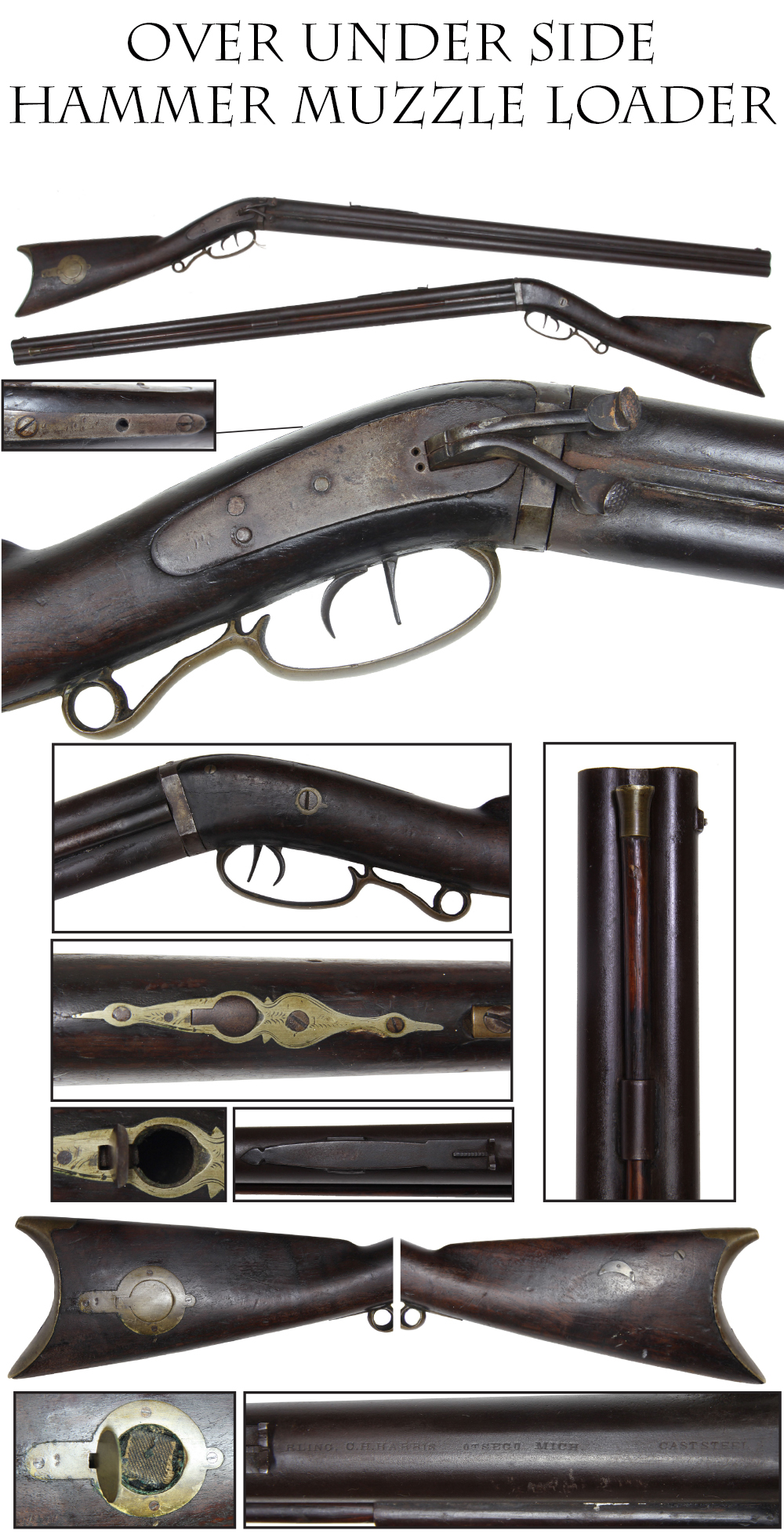
17-05-86….DARLING AND HARRIS MICHIGAN MADE OVER & UNDER MULE EAR SIDE HAMMER RIFLE & SHOTGUN COMBO:… You have to love side-hammer guns: like the wife of the old farmer, who was, “not much for pretty, but hell for strong.” This one sports a 45 caliber rifle barrel over a 12 gauge shotgun barrel. The mechanism was simple, but effective. The upper barrel is stamped “ ..]rling. C.H. Harris Otsego Mich” on the top (and also marked “cast steel,”) the left being partly obscured by the long rear sight. This is certainly the mark of William K. Darling and C.H. Harris, who worked as gunsmiths in Otsego (Allegan County) Michigan and are recorded in Chapin’s 1867-1868 business directory for the state, though they were certainly in business much earlier. This gun must have been a good one and well liked by the owner. The tang has provision for a lollipop peep sight in addition to the standard sights present on the top of the barrel. Double set triggers actuate the side hammers. The top hammer cocks and functions. The shotgun hammer has good spring tension but the sear is worn and it will not stay on cock. The ramrod is side mounted on the left. The trigger guard is rather crudely cast, and the gun is decorated sparsely with a small brass patch box in the right butt, which still has some patches in it, a small compartment on the underside behind the trigger guard tang for caps, and an inlaid silver crescent moon on the left butt flat. The lock is mounted with a single side screw. A wood screw shows on the upper left butt flat just forward of the brass crescent butt plate, but what its function was is unclear since there is no repair, and it doesn’t appear to secure any part of portion of the gun. A very folky rifle, full of character circa 1860.
$1,295.00
Call us @ 419-842-1863
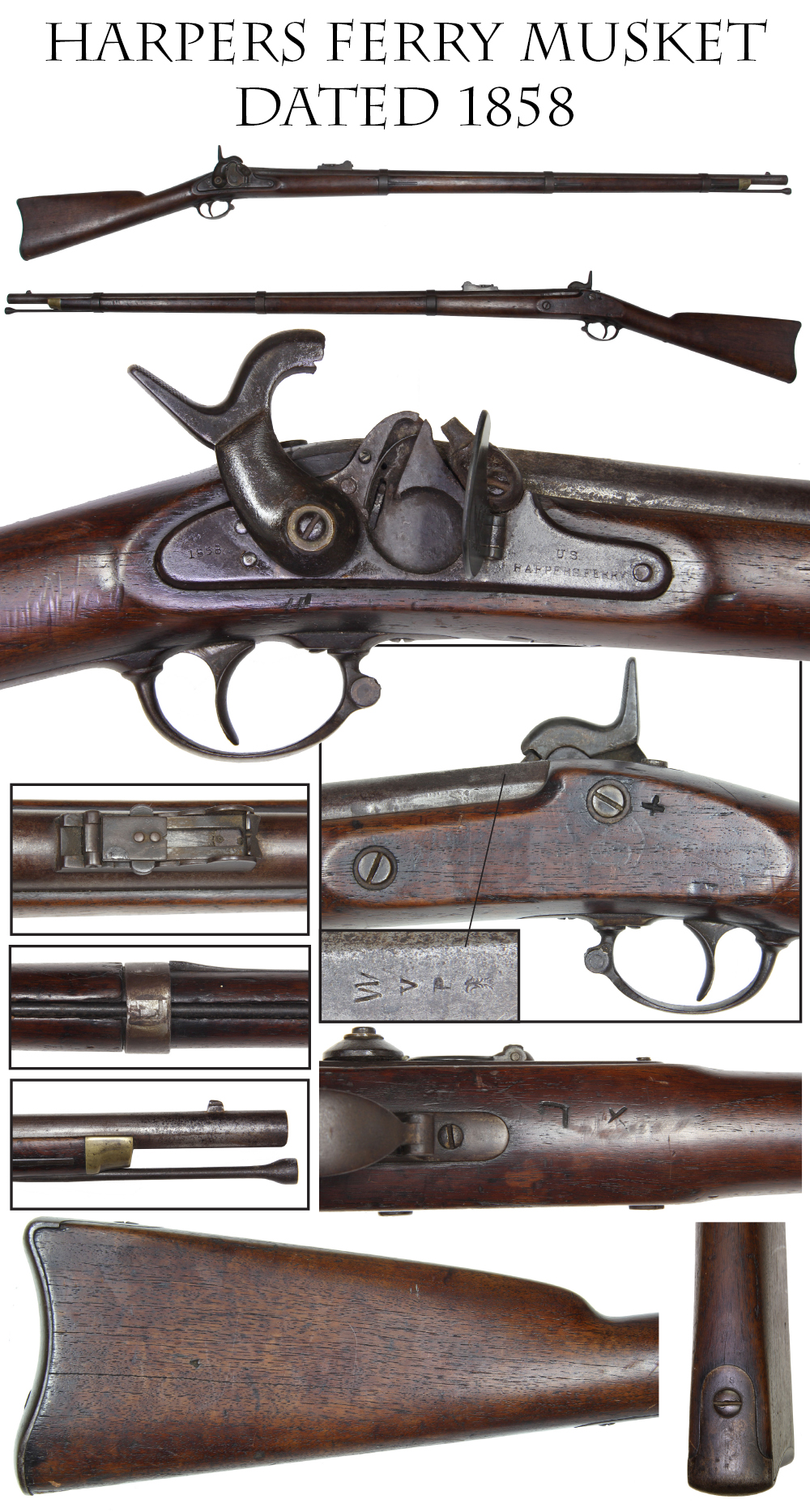
17-05-87…LIKELY CONFEDERATE USED HARPERS FERRY 1855 TYPE – I MUSKET DATED 1858… U.S. 1855 pattern rifle musket produced at the “armory of the South” at Harpers Ferry, Virginia in 1858. This is a standard first model musket with correct brass nose cap, stock without patchbox, and early style long range rear sight. Both sights, all bands, springs and rod in place. Swivels have been removed from the triggerguard and the upper band. Lock plate markings are clear. Some light corrosion to the plate. Heavier on the bolster from firing. Hammer screw is an old replacement and the primer door is a proper replacement which we restored. Other metal generally smooth and silver gray. Some darker spotting near the muzzle. Clear V/P/eagle head barrel proofs with a “W” added above them with individual lines. Some spot in my faulty memory associates this crude “W” with Richmond arms, but I cannot call it to the forefront, and am too lazy to dig through my books. Let me know if you know. A small “x” is carved next to the upper lock screw and on the underside forward of the triggerguard, along with what looks like the upper portion of a “7.” Wood is generally very good, with some slight hairlines in the butt flat and behind the lock plate, but with a tight fit to the lock plate and the visible outlines of a cartouche on the left flat. These rifle muskets were part of the 1855 series of US arms that introduced the .58 caliber Minie ball and other innovations, and this one has a special cachet, coming from the renowned armory at Harpers Ferry, attacked by John Brown before the war and seized by Virginia troops at the beginning of the war. It is hard to stress enough the degree to which Harpers Ferry made examples are rarer than their Springfield made counterparts. The Springfield 1855s are scarce, desirable, and highly sought. In contrast, the Harpers Ferry guns are perhaps 50 times harder to find for sale. Most were used up during the war. Many if not most were used by the South. And most surviving Harpers Ferry examples show hard use and abuse. This one is a VG example, and is absolutely genuine Harpers Ferry from muzzle to butt plate. $2950.00
sold
Call us @ 419-842-1863
Layaways are Welcome
Need to split your order into multiple payments? No problem! A simple 20% earnest money deposit will hold your item for you.-acf
You can then pay it off in easy installments that fit your budget.
Read Terms Here
Items to Sell? Contact Us
I am always interested in buying ANYTHING from the American Civil War… Guns, Swords, Civil War Muskets, Knives, Uniforms, Flags, Medals, Badges, Diaries, Letters, Autographs, Buttons, photographs, tintypes, daguerreotypes, Insignia, Camp Items, Battlefield Relics, canteens, Drums, Etc… Call 419-842-1863 and ask for Dave Taylor.

